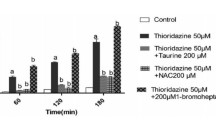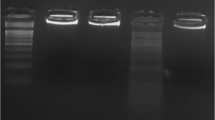Abstract
The protective effect of N-acetylcysteine against the toxicity of paracetamol, acrolein, and paraquat was investigated using isolated hepatocytes as the experimental system. N-acetylcysteine protects against paracetamol toxicity by acting as a precursor for intracellular glutathione. N-acetylcysteine protects against acrolein toxicity by providing a source of sulfhydryl groups, and is effective without prior conversion. Paraquat toxicity can be decreased by coincubating the cells with N-acetylcysteine, but the mechanism for the protective effect is not as clear in this instance. It is probable that N-acetylcysteine protects against paraquat toxicity by helping to maintain intracellular glutathinone levels.
Similar content being viewed by others
References
Berrigan MJ, Gurtoo HL, Sharm SD, Struck RF, Marinello AJ (1980) Protection by N-acetylcysteine of cyclophosphamide metabolism-related in vivo depression of mixed function oxygenase activity and in vitro denaturation of cytochrome P-450. BBRC 93: 797–803
Brigelius R, Hashim A, Lengfelder E (1981) Paraquat-induced alterations of phospholipids and GSSG-release in the isolated perfused rat liver, and the effect of SOD-active copper complexes. Biochem Pharmac 30: 349–354
Bus JS, Cagen SZ, Olgaard M, Gibson JE (1976) A mechanism of paraquat toxicity in mice and rats. Toxicol Appl Pharmacol 35: 501–513
Cox PJ (1979) Cyclophosphamide cystitis — identification of acrolein as the causative agent. Biochem Pharmacol 28: 2045–2049
Davies DS, Conolly ME (1975) Paraquat poisoning — possible therapeutic approach. In: Junod AF, DeHaller R (eds) Lung Metabolism. Academic Press, New York, p 275
Freeman RW, MacDonald JS, Olson RD, Boerth RC, Oates JA, Harbison RD (1980) Effect of sulfhydryl-containing compounds on the antitumour effects of adriamycin. Toxicol Appl Pharmacol 54: 168–175
Galinsky RE, Levy G (1979) Effect of N-acetylcysteine on the pharmacokinetics of acetaminophen in rats. Live Sci 25: 693–700
Golden DP, Mosby EL, Smith DJ, Mackercher P (1982) Acetaminophen toxicity: Report of two cases. Oral Med 51: 385–389
Grassi C, Morandini GC, Frigerio G (1973) Critical evaluation of systemic acetylcysteine by different routes of administration. Curr Ther Res 15: 165–179
Haley TJ (1979) Review of the toxicology of paraquat. Clin Toxicol 14: 1–46
Hissen PJ, Hilf R (1976) A fluorimetric method for determination of oxidized and reduced glutathione in tissues. Anal Biochem 74: 214–226
Högberg J, Kristoferson A (1977) A correlation between glutathione levels and cellular damage in isolated hepatocytes. Eur J Biochem 74: 77–82
Ilett KF, Stripp B, Menard RH, Reid WD, Gillette JR (1974) Studies on the mechanism of the lung toxicity of paraquat: Comparison of tissue distribution and some biochemical parameters. Toxicol Appl Pharmacol 28: 216–226
Izard C, Libermann C (1978) Acrolein. Mutat Res 47: 115–138
Jee RC, Sipes G, Gandolfi AJ, Brown Jr. BR (1980) Factors influencing halothane hepatotoxicity in the rat hypoxic model. Toxicol Appl Pharmacol 52: 267–277
Levy L, Harris R (1977) Effect of N-acetylcysteine on some aspects of cyclophosphamide-induced toxicity and immunosuppressin. Biochem Pharmacol 26: 1015–1020
Lin JH, Levy G (1981) Sulfate depletion after acetaminophen administration and replenishment by infusion of sodium sulfate or N-acetylcysteine in rats. Biochem Pharmacol 30: 2723–2725
Mitchell JR, Corcoran GB, Hughes H, Lauterburg BH, Smith CV (1981) Acute lethal liver injury cause by chemically reactive metabolites. In: Brown SS, Davies DS (eds) Organ-directed toxicology. Chemical indices and mechanisms. IUPAC Series, Pergamon Press, Oxford, p 117
Moldéus P (1978) Paracetamol metabolism and toxicity studied in isolated hepatocytes from mouse. In: Aitio A (ed) Conjugation reactions in drug biotransformation. Elsevier/North-Holland Biomedical Press, Amsterdam, p 293
Moldéus P, Gergely V (1980) Effect of acetone on the activation of acetaminophen. Toxicol Appl Pharmacol 53: 8–13
Moldéus P, Högberg J, Orrenius S (1978) Isolation and use of liver cells. In: Fleischer S, Packer L (eds) Methods of enzymology 52. Academic Press, New York, p 60
Multicenter Study Group (1980) Long-term oral acetylcysteine in chronic bronchitis. A double-blind controlled study. Eur J Respir Dis 61: 93–108
Pasi A (1978) In: The toxicology of paraquat, diquat and morfamquat. Hans Huber, Bern
Reed DJ, Orrenius S (1977) The role of methionine in glutathione biosynthesis by isolated hepatocytes. Biochem Biophys Res Commun 77: 1257–1264
Seglen PO (1976) Incorporation of radioactive amino acids into protein in isolated rat hepatocytes. Biochim Biophys Acta 442: 391–404
Thor H, Moldéus P, Orrenius S (1979) Effect of cysteine, N-acetylcysteine and methionine on glutathione biosynthesis and bromobenzene toxicity in isolated rat hepatocytes. Arch Biochem Biophys 192: 405–413
Whitehouse LW, Wong LT, Solomonraj G, Paul CJ, Thomas BH (1981) N-acetylcysteine-induced inhibition of gastric emptying: a mechanism affording protection to mice from hepatotoxicity of concomitantly administered acetaminophen. Toxicology 19: 113–125
Zitting A, Heinonen T (1980) Decrease of reduced glutathione in isolated rat hepatocytes caused by acrolein, acrylonitrile and the thermal degradation products of styrene copolymers. Toxicology 17: 333–341
Author information
Authors and Affiliations
Rights and permissions
About this article
Cite this article
Dawson, J.R., Norbeck, K., Anundi, I. et al. The effectiveness of N-acetylcysteine in isolated hepatocytes, against the toxicity of paracetamol, acrolein, and paraquat. Arch Toxicol 55, 11–15 (1984). https://doi.org/10.1007/BF00316579
Received:
Accepted:
Issue Date:
DOI: https://doi.org/10.1007/BF00316579




